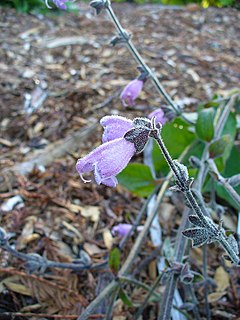
Salvia hians is a mound forming perennial, native to the Himalayas from Pakistan to Bhutan. It is common in Kashmir, growing at 2,400 to 4,000 m on open slopes and forests.
The plant was described in 1830 by John Forbes Royle, a British botanist living in India who studied the medicinal properties of Himalayan plants.

Salvia leucophylla, the San Luis purple sage, purple sage, or gray sage, is an aromatic sage native to the southern coastal mountain ranges of California and Baja California.

Salvia lyrata, is a herbaceous perennial in the family Lamiaceae that is native to the United States, from Connecticut west to Missouri, and in the south from Florida west to Texas. It was described and named by Carl Linnaeus in 1753.
Salvia sprucei is a herbaceous perennial in the Lamiaceae family that is native to Ecuador, growing at 7,000 feet (2,100 m) elevation or higher in thick scrub on steep slopes. It was named in 1898 by botanist John Isaac Briquet for the British plant collector Richard Spruce. It is likely that Spruce discovered the plant on a collecting trip in Ecuador in 1857.

Salvia brandegeei, the Santa Rosa Island sage or Brandegee's sage, is a perennial evergreen shrub that grows to 3–4 feet in its native habitat. For many years, it was thought to be native only to Santa Rosa Island, one of the Channel Islands of California. In the 1960s and 1970s six colonies were found in Baja California. In cultivation, the plant will reach 4–5 feet tall and up to 7 feet (2.1 m) wide. It has dark green scalloped leaves, about 3-4 inches long and 0.5 inch wide. The pale lavender flowers are about 0.5 inch long, in tightly spaced whorls. The violet-gray calyx, combined with the wide open flower lips, make it a very showy flower.

Salvia karwinskii is a perennial shrub native to the moist mountain forests of Mexico, Guatemala, Honduras, El Salvador, and Nicaragua, typically growing in or near pine or oak forests at 4,000 to 8,000 feet elevation. It is known as a honey-producing plant in those areas, but is rarely seen in private gardens. Specimens are grown at Strybing Arboretum, Huntington Botanical Gardens, and University of California Botanical Garden.
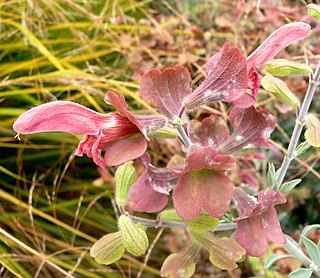
Salvia lanceolata is a perennial shrub native to a small area of coast on the Cape of Good Hope in South Africa. It is typically found growing in sandy ground at sea level, and on dry hills and flat ground up to 1000 feet elevation. Jean-Baptiste Lamarck, a pioneer in evolutionary theory, first described and named the plant "lanceolata" in 1791. Swedish botanist Carl Peter Thunberg, who was delayed in South Africa on the way to Japan, first collected it nearly twenty years earlier, along with approximately 3,000 plants that he later described. It wasn't until 1800 that Thunberg gave the plant the specific epithet "nivea", meaning 'snowy' in Latin, referring to the color of the foliage. Because of the rules of nomenclature, Lamarck's name had precedence because he was the first to name it.

Salvia longispicata is a perennial shrub native to southwestern Mexico, growing between 1,000 and 6,500 feet elevation. The specific epithet "longispicata" gives the impression that the plant has "long spikes", but instead refers to the many projecting clusters of short flowering spikes that resemble small ears of corn.
Salvia lycioides is a perennial native to a wide area ranging from west Texas and New Mexico in the U.S., south through Mexico to the state of San Luis Potosi. It typically grows on dry limestone hills and canyons above 5,000 feet elevation. It was named in 1886 by Asa Gray, the most respected American botanist of the 19th century. The specific epithet, "lycioides", from the Greek, is due to the plant's resemblance to Lycium, a genus also known as "boxthorn" in the nightshade family.
Salvia merjamie is a herbaceous perennial plant that is native to the east African highlands from Ethiopia to Tanzania, and also across the Red Sea in Yemen. It grows between 6,000 and 13,000 feet elevation in grasslands, forest edges, rocky outcrops, basalt slopes, and fallow fields. The specific epithet merjamie is derived from meryamiye, the Arabian common name for the plant, which is shared with other local Salvia species such as Salvia lanigera. The Maasai common name for S. merjamie is Naingungundeu, meaning that the plant smells of rats, though the variety that is common in horticulture is named 'Mint Sauce' and is described as having a strong minty aroma. S. merjamie shares a similar distribution with Salvia nilotica, though they are not known to hybridize.
Salvia namaensis is an evergreen perennial shrub native to a limited area in Namibia and a wide area of South Africa. It is typically found growing on rocky slopes, shales, limestone hills, and sandy soils at 1,000 to 5,000 feet elevation. The specific epithet namaensis probably refers to the Nama tribe which is indigenous to Namaqualand, the region in Namibia where the plant grows.
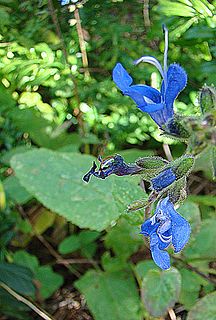
Salvia scutellarioides is an evergreen perennial native to the Andes Mountains in Ecuador, Colombia, and Peru, growing at elevations from 3,300 to 10,000 feet in mild climates where there is year-round moisture. Even though it was described by Carl Sigismund Kunth in 1817, as of 2002 it was still rarely seen in horticulture. The specific epithet is due to its similarity to Scutellaria, a genus in the mint family.
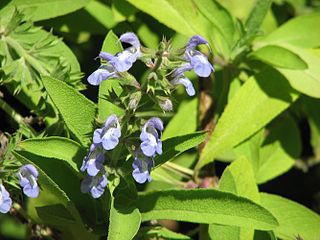
Salvia somalensis is a perennial shrub endemic to a limited range and elevation in Somalia. It grows at elevations from 4,000 feet (1,200 m) to 7,000 feet (2,100 m), typically in forest clearings or edges as a common or dominant subshrub.
Salvia staminea is a herbaceous perennial shrub native to a wide area in Asia Minor that includes Turkey, Georgia, Armenia, and Iran, where it grows at elevations from 6,000 feet (1,800 m) to 14,000 feet (4,300 m). It is typically found growing in alpine meadows, screes, and cliffs, sometimes growing with scrub oak. Due to the wide variety of habitats in which it is found, there is a wide degree of variation in the species. It was first described in 1836 and has only slowly come into use in horticulture.
Salvia taraxacifolia is a herbaceous perennial shrub that is native only to southwest Morocco, growing in the Atlas Mountains at elevations ranging from 2,000 feet (610 m) to 8,000 feet (2,400 m). Very adaptable, it grows on limestone slopes, forest clearings, and rocky riversides. It has no close allies in the genus Salvia. The specific epithet, taraxacifolia, is likely Persian in origin and means 'leaves shaped like a dandelion'.
Salvia tubiflora is a perennial native to a small area of western Peru and northern Chile near the tropic of Capricorn, growing at elevations from 800 feet (240 m) to 1,600 feet (490 m).
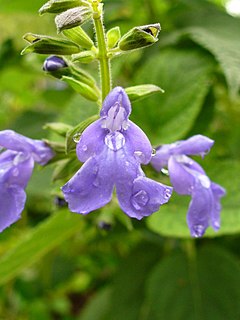
Salvia urica is a herbaceous perennial native to the mountains of Guatemala, Honduras, Belize, and Chiapas, Mexico. It is reportedly most common in Guatemala, where it grows in a wide variety of habitats from 1,000 to 8,000 feet elevation, in a mild and moist climate. The specific epithet, urica, means "caterpillar" or "cankerworm", possibly describing the tight whorls of flowers, calyces, and bracts before they open.
Salvia villosa is a herbaceous perennial that is native to the Mexican states of San Luis Potosi and Coahuila, growing at approximately 4,000 feet (1,200 m) elevation in dry areas that have little or no frost.

Salvia viscosa is a herbaceous perennial native to a small area of mountains in Lebanon and Israel. It was first described in 1781 by Nikolaus Joseph von Jacquin but only began being sold in nurseries in the 1990s.
Salvia wagneriana is a perennial found in Nicaragua, Costa Rica, Guatemala, El Salvador, and the Mexican state of Chiapas, growing at 4,000 to 6,500 feet elevation in warm, moist areas. It is very popular among gardeners near its native habitat, and one of the few native plants taken from the wild by local gardeners. It is described sometimes as a herb and sometimes as a shrub by various botanists.














